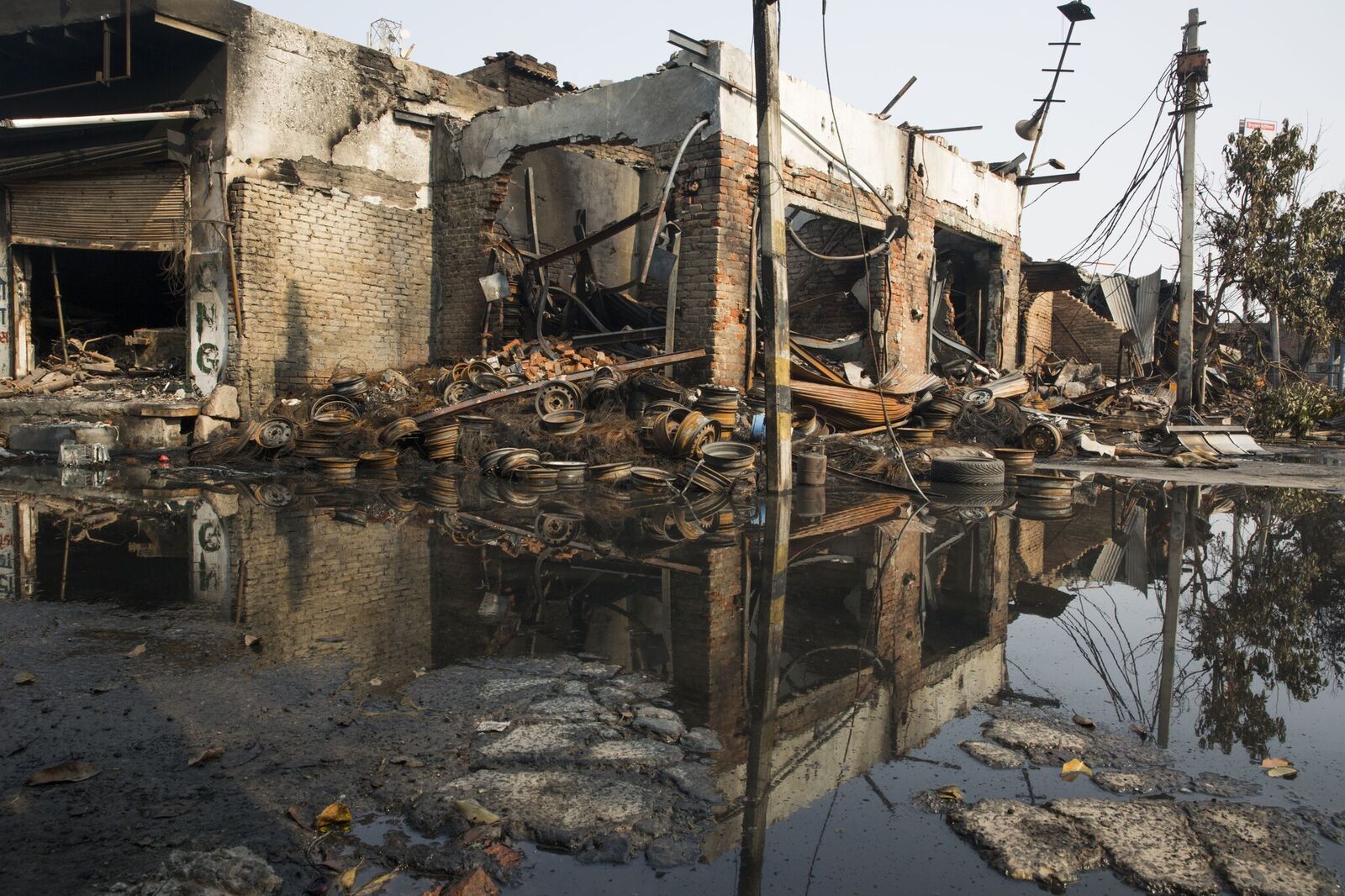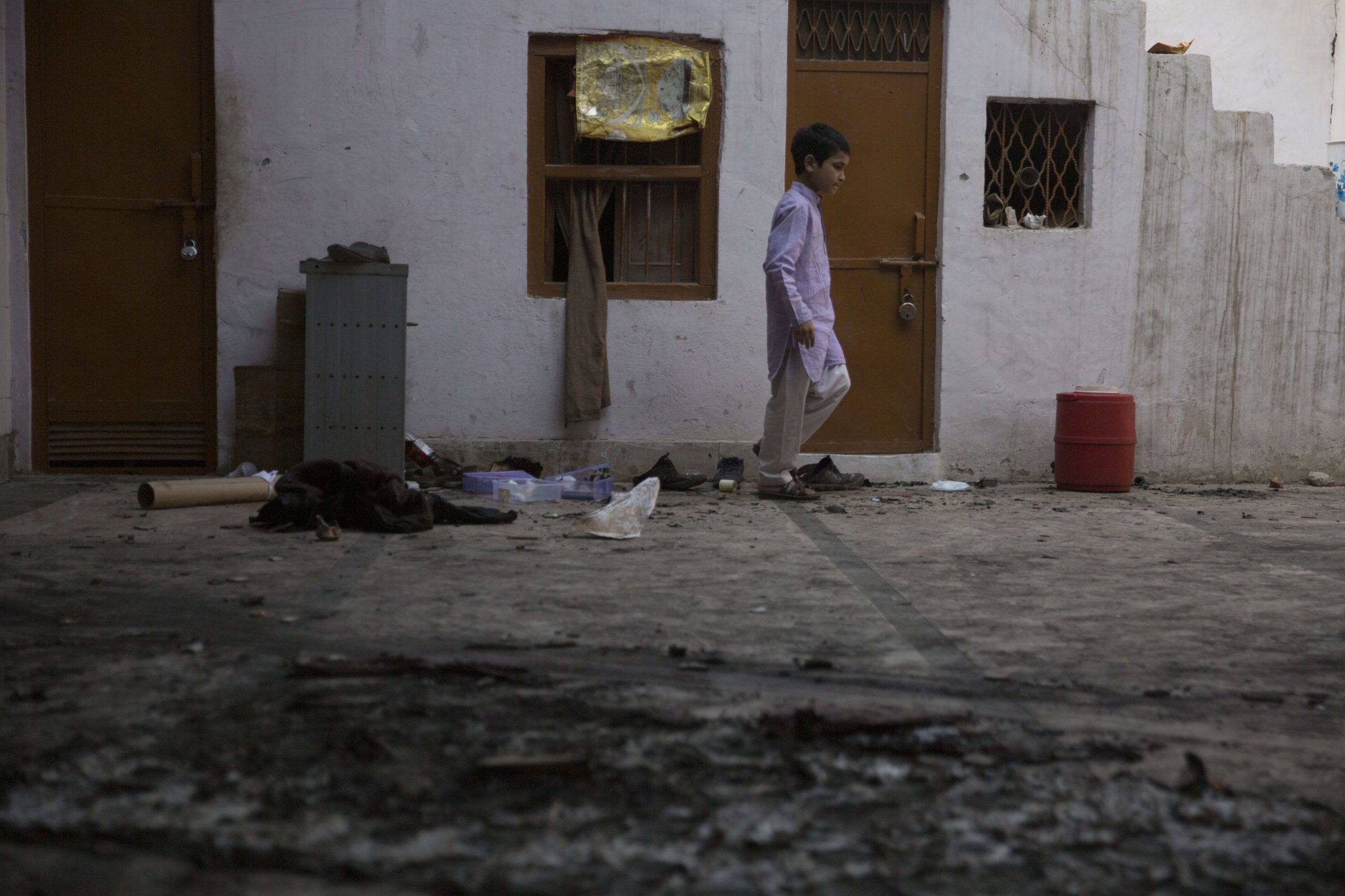

As the north-east part of the capital inches towards normalcy, Ruhani Kaur and Gunjeet Sra visit the riot affected areas
As we make our way to a police barricade in Seelampur, New Delhi, loaded buses filled with Rapid Action Force (RAF) whizz past in the opposite direction, a water cannon tanker follows behind and a cavalcade of white police cars makes its way inside. The silence of the deserted streets is punctuated by loud sirens. Some dogs linger nearby.
The first sign of human life is in a ramshackled protest site being guarded by four people, two on either side. Inside, demarcations have been made a rope for the men and women. Some women are praying silently on their mats and some are huddled at the front on the stage area, screaming Inquilab Zindabad (long live the revolution) into a television camera. A woman who has styled herself as a leader in the crowd, comes forth and only identifies herself as Sultana says, “We moved from the protest side in Jaffrabad after violence broke out on February 24, after talking to the DCP, who advised us to continue our peaceful protest elsewhere. The whole thing started after Kapil Mishra gave a speech telling the Hindus to target the protesting Muslims. We will continue to protest but will now also protest to get Mishra arrested.” She goes on to say that even though the community was displaced and harassed, it hasn’t been met with any sympathy from any political leaders, “Even though we voted Kejriwal into power, no one has come forth and addressed our plight or even shown any kind of solidarity.” She then politely asks us to leave.
 Jaffrabad in the North east part of Delhi found itself to be at the center of violent clashes between pro CAA and anti CAA supporters on February 24, the violence then spread out to nearby areas as clashes continued into the early hours of the 26th. So far 38 have been killed and over 200 injured, including an intelligence officer.
Jaffrabad in the North east part of Delhi found itself to be at the center of violent clashes between pro CAA and anti CAA supporters on February 24, the violence then spread out to nearby areas as clashes continued into the early hours of the 26th. So far 38 have been killed and over 200 injured, including an intelligence officer.
Down the street, CRPF guards are biding their time, playing on their phones, catching a break amidst the rubble on the streets; a few men hover nearby, just looking at the ongoing tableau. A father escorts his daughter back home from school; he is limping because he’s been walking a long way. Families are out on their rooftops, huddled together, waiting.
A burnt tractor abandoned on the road along with skeletons of bikes that were set ablaze, red rubble—remnants of stone pelting as far as you can see. Empty metro stations, a long stretch of barricades punctuated by armed guards, and a father escorting his daughter back from school.
 Less than 500 meters from a police station is the Gokulpuri tyre market before it was set ablaze, a man is on a video call with his friend, picking up something from the rubble on the ground he tells the person on the phone, “yeh le! teri gaadi ke naye alloys!” (Here are new alloys for your car). The air is rancid here—the smell of burnt plastic, mixed with petrol hangs heavily in the air, everything around is charred. In the center of the market lie two burnt cars, there is a fire brigade next to it, the on duty officer says it is their third visit to the place, “It has been hard to douse and you have come late, you should have seen it two days ago,” he says. When asked for his name, he says he is not authorised to say anything but if I tell him mine, he can tell me some things.
Less than 500 meters from a police station is the Gokulpuri tyre market before it was set ablaze, a man is on a video call with his friend, picking up something from the rubble on the ground he tells the person on the phone, “yeh le! teri gaadi ke naye alloys!” (Here are new alloys for your car). The air is rancid here—the smell of burnt plastic, mixed with petrol hangs heavily in the air, everything around is charred. In the center of the market lie two burnt cars, there is a fire brigade next to it, the on duty officer says it is their third visit to the place, “It has been hard to douse and you have come late, you should have seen it two days ago,” he says. When asked for his name, he says he is not authorised to say anything but if I tell him mine, he can tell me some things.
Once assured that I am “their people,” he tells me the Newton’s third law of physics. “For every action, there is an equal and opposite reaction, madam. Ye to badla tha, aap dekho unhone hamara kitna nuksaan kiya hai aur jagah. Aur yeh to second hand tyre market hai, yahan pe kitna hi paisa barbaad hua hoga. ” (This was an act of revenge, you should see the kind of damage they have done to us elsewhere and this is a second hand market, it’s not worth a lot anyway.)

In stark difference to Seelampur, Jaffrabad and its neighbouring areas, inside Gokulpuri, the atmosphere is slowly inching back to normal. Even though the shops are closed and there are barricades every 200 meters, people are out on the streets and their front porches mingling, talking to their neighbours, exchanging stories. Signs of arson are evident in places but there is no red rubble of stone pelting, the temple too is untouched. In the left hand corner of a small alley, there is an isolated burnt down mosque, the RAF guard deployed outside it doesn’t want it photographed, “log phir bhadak jayenge,” he says. (People will be triggered all over again)
The narrow street lined with shops that lead into the largely residential Brijpuri face a wall that is filled with revolutionary messages, images of Bhagat Singh, Gandhi and anti CAA sentiments are plastered on it. Ambulances whizz through it every couple of minutes, the thick rubble on the street makes it hard to walk, some houses stand charred, hissing, and emanating smoke. The walls of the now defunct Brijpuri protest site that was razed to the ground has, “Hum sab ek hai,” graffiti, (We are one). Opposite it is a table filled with empty first aid kits, right next to is a mosque that has been burnt down.

Rabia Hussein, a local resident who is inside the mosque assessing the damage points to blood and a police baton lying on the floor when she says, “they (the police) helped do this. There were 150 people inside when this happened, including children when they attacked. Some other residents had to climb over pipelines to rescue them, even then the children were so scared, and they thought the people had come to attack them.” Hussein says that she and some others from her community helped guard the Hindu temples and even their shops. “Even now, we are not allowing our children this side because we do not want them to see this and be provoked. What can we do? We have nothing.”
 The walls of Farooqi masjid, as it’s known locally, are still seething, fumes loom large and a six year old boy, who is wandering inside the mosque keeps repeating, “sab jala dala,” (They burnt everything down). He takes us to what used to be a children’s dormitory, on the farthest end are the boys lockers, they too have been burnt down, small trunks lie open in corners, belongings of children who called this home.
The walls of Farooqi masjid, as it’s known locally, are still seething, fumes loom large and a six year old boy, who is wandering inside the mosque keeps repeating, “sab jala dala,” (They burnt everything down). He takes us to what used to be a children’s dormitory, on the farthest end are the boys lockers, they too have been burnt down, small trunks lie open in corners, belongings of children who called this home.
An Indian flag is hoisted on the minarat. “Unhone fateh kari hai,” (they’ve declared victory), says Irfan, a 33-year-old resident of Brijpuri, who is here to assess the damage.
The locals say that no fire brigade had reached the area despite repeated calls from them. Rumours are rife that the Imam of the mosque succumbed to his injuries. Dr. Shahzad who runs Mehar Nursing Home, a small hospital in Mustafabad, bordering Brijpuri says, he cannot confirm the death of the Imam as he didn’t treat him. The injured started coming to the nursing home on the evening of the 25th between 3.30-4 pm. “Anyone who was serious , I referred them to higher centers and as we were not equipped enough to deal with critical cases like bullet wounds. The major hospitals are around 10-12 kms away, many patients died on the way or in this hospital. I myself called the police for the first time at 7 pm, then at 9 pm and then 11 pm. They came at 4.45 am,” he says.
images courtesy Ruhani Kaur